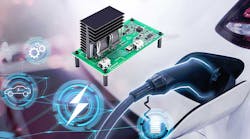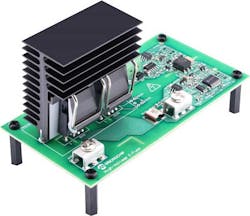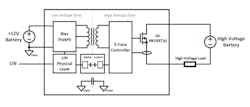SiC E-Fuse Demonstrator Speeds Evaluation for EV Apps
This article is part of the TechXchange: Silicon Carbide (SiC).
You have to feel some empathy for the classic thermally activated fuse, which has faithfully served electrical engineers at all power levels for well over a hundred years. Despite its virtues—and there are many—it has been supplemented, supplanted, and even superseded in many cases by the electronic fuse, or e-fuse. Putting nostalgic feelings aside, there’s no arguing the many benefits of the e-fuse: adjustability, resettability, flexibility, and remote, I/O-based setting and readback, to cite a few.
Billions of thermal fuses are still used annually, and there’s also no denying that the operating and functional simplicity of the thermal fuse is also a virtue in its own way. Look at it this way: Once you select the desired type and rating, there’s nothing more to do to make it operational—no initialization, no settings; you just install it and it’s ready to function. It’s the passive-component equivalent of “plug and play.”
The scenario different for e-fuses, and this is the challenge addressed by the E-Fuse Demonstrator Board from Microchip Technology Inc., enabled by the company’s 700- and 1,200-V silicon-carbide (SiC) technology (Fig. 1).
It gives designers of pure battery and hybrid electric vehicles (BEVs and HEVs) a faster and more reliable high-voltage circuit-protection solution. The board is available in six variants for 400- to 800-V battery systems, with current ratings of 10, 20, and 30 A (Fig. 2). Note that the hardware design uses only AEC-qualified components for compatibility with automotive bill-of-materials requirements and technical mandates.
Due to its high-voltage solid-state design, the E-Fuse Demonstrator can detect and interrupt fault currents in 10 µs, which is far faster than the traditional approaches. This fast response time substantially reduces peak short-circuit currents from tens of kiloamps down to hundreds of amps, and thus can prevent a fault event from resulting in a hard failure.
With the E-Fuse Demonstrator’s resettable feature, designers can easily package an e-fuse in the vehicle without the burden of design-for-serviceability constraints. This reduces design complexities and enables flexible vehicle packaging to improve BEV/HEV power system distribution.
Furthermore, the E-Fuse Demonstrator accelerates development of SiC-based auxiliary applications due to its built-in Local Interconnect Network (LIN) communication interface. This interface enables the configuration of the overcurrent trip characteristics without the need to modify hardware components, and it reports diagnostic status.
Low-voltage operating range is 9 to 16 V, while the high-voltage operating range is 200 to 900 V. This design also implements a time-current characteristic (TCC) curve that helps designers migrate to non-automotive applications such as dc solid-state circuit breakers.
Full details on the Demonstrator are provided by the 74-page High-Voltage Auxiliary E-Fuse User’s Guide. This is supplemented by the MPLAB X integrated development environment (IDE), which enables designers to quickly develop or debug software, while the LIN Serial Analyzer development tool allows them to easily send and receive serial messages from a PC to the E-Fuse Demonstrator Board.
Read more articles in the TechXchange: Silicon Carbide (SiC).


